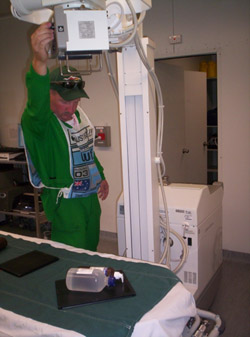WiMax races to medical aid

At auto racing events, high-speed wireless communication is just as important as keeping the cars in high gear. Auto racing events require a medical team capable of attending to the steady stream of injuries incurred by the drivers, mechanics and other personnel throughout the competition.
In 2006, organizers of the Australian Grand Prix teamed up with Intel Australia and Airspan Networks to hook up the trackside trauma facility with high-speed wireless connection, linking the on-site medical staff with their counterparts at The Alfred Hospital three kilometers away.
The WiMax network eliminated the need for the 20-minute trips previously required to manually transport radiology images, test results and other medical information between sites.
 X-ray images could be sent from the field back to the hospital using WiMAX |
In previous years, prescriptions were written down and faxed back and forth between the hospital and the remote medical facility. And because radiologists could not afford to take four days off from their regular work responsibilities to assist at the event, digital radiology files had to be saved on a CD-R and physically driven between the sites on a trip that took 20 minutes each way during peak traffic hours.
However, broadband connectivity at last year's event opened up onsite medical care to new possibilities. Medical staff could treat patients more quickly, as the wireless link enabled an image to be sent to the hospital and interpreted quickly.
D-Link wireless Web cameras installed at the remote site allowed medical staff in the field to run real-time video consultations and patient reviews with their colleagues in the hospital.
Cathie Steele, general manager of the Australian Centre for Health Innovation at The Alfred Hospital, told ZDNet Asia in an e-mail that the project was not without challenges.
"Challenges included defining a secure, dependable and yet cost-effective solution that would only take two to three days to deploy for the temporary Emergency Medical Centre for the Grand Prix," Steele said.
"For the Wireless ICU, the key challenge was testing and trialing a large range of communication devices and medical equipment such as ventilators and other life support machines to ensure that there was no interference from the wireless systems deployed."
According to Steele, the project is believed to have been the first of its kind in Australia, and a wireless medical facility was also implemented at the Turkish Grand Prix in August last year.
More behind-the-scenes photos in our photo gallery.